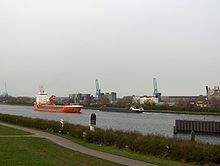Ghent – Terneuzen Canal
The Zeekanaal Gent – Terneuzen , also called Kanaal van Gent naar Terneuzen , connects the seaport of the Belgian city of Ghent - the capital of the province of East Flanders - with the Dutch arm of the Westerschelde and thus with the North Sea . In addition to Ghent, the canal crosses the municipalities of Zelzate in Belgium and Terneuzen in the Netherlands.
The canal is of great importance for the port of Ghent (the third largest in Belgium), for the economy of the port city of Ghent and for industrial companies in the region.
history
The forerunner of the canal was the Sassevaart, opened in 1549. In 1823 the Dutch King Wilhelm I decided to extend this to Terneuzen. The construction of the new canal from Gent to Sas van Gent ran largely in the old bed of the Sassevaart, from Sas van Gent to Terneuzen through alluvial land that was rarely flooded (De Braeckmaninham, Sassegat and Axelse Gat). Two locks were built in Terneuzen , one eight meters wide and one twelve meters wide.
In 1827 the canal was opened by Pieter van Doorn, governor of East Flanders , on behalf of the king. Up to Sas van Gent the canal was 4.5 m deep and up to Gent 2.5 m deep. At the bottom of the water it was ten meters wide, at the water level it was 24 meters. On the occasion of the opening of the canal, bread was distributed to the poor and commemorative medals were minted in gold, silver and bronze.
Between 1830 and 1841 there was no shipping from Terneuzen to Ghent due to the separation of Belgium from the United Netherlands . At the height of Zelzate , the Belgian general Charles Niellon had stakes driven into the canal so that Dutch ships could no longer sail to Ghent. Only in 1841, after the sanded canal had been dredged, did ships go there again.
From 1870 the canal was deepened and widened, obstructive curves were straightened and at Zelzate the canal was relocated by a new branch. Several bridges were built on Belgian territory. In 1881 the work was completed there. In the Netherlands, the canal was deepened and widened from 1881; A third arm of the canal was dug in Sas van Gent and a new lock was built. In 1885 the channel was 6.5 m deep, 17 m wide at the bottom and 68 m wide at the surface.
In a contract between the Netherlands and Belgium on June 20, 1960, the further expansion of the canal was decided. Part of the village of Sluiskil had to give way to the canal. In 1963 two new locks were built in Terneuzen, one for inland waterway vessels and the second for seagoing vessels. The old lock at Sas van Gent was filled in; the driveway for a new bridge was laid there. On December 19, 1968, the new canal was inaugurated by Queen Juliana (Netherlands) and King Baudouin I.
Expansion plans
The Gent – Terneuzen canal is now 200 meters wide and 32 km long. Seagoing ships up to 125,000 tons can use it. The largest permissible dimensions are 265 × 34 × 12.5 meters. So it is too small for Panamax ships (see also ship sizes and waterways ).
Currently (as of March 2014) there are plans to enlarge the congested locks in Terneuzen in the Netherlands so that larger ships can access them. The construction costs of the new, 427 meters long, 55 meters wide and 16 meters deep lock are estimated at around 930 million euros. They should also be supported by Belgium (788.1 million euros): by the Flanders region and the city of Ghent, if possible with the support of the EU.
On February 5, 2015, the Netherlands and Flanders signed a contract to build the Terneuzen lock. The groundbreaking ceremony took place in November 2017 . The opening is planned for 2022.
Web links
- Portaal van Vlaanderen (Dutch, German, English, French)
- Overview map: Waterways in Belgium (PDF; 231 kB)
Individual evidence
- ↑ For more details, see Dutch Wikipedia
- ↑ More about Niellon in the French Wikipedia
- ↑ Eckhard-Herbert Arndt: Ghent shouldered the largest single investment - The Flemish port contributed 118 million euros to the total costs of the new locks in Terneuzen . In: Daily port report , March 19, 2014, p. 15, ISSN 2190-8753
- ↑ see also the 2013 annual report of the 'Havenbedrijf Gent nv: 2013 annual report ( Memento of the original from March 4, 2016 in the Internet Archive ) Info: The archive link has been inserted automatically and has not yet been checked. Please check the original and archive link according to the instructions and then remove this notice. : For starters, Flanders and the Netherlands came together and arrived at a major collective decision to build a new, larger sea lock in Terneuzen by 2021. In the summer of 2013, the Flemish-Dutch project team put an engineering firm in charge of drawing up the plans for this sea lock, and several studies are intended to result in a draft route resolution by early 2015.
- ↑ IHS Maritime 360 / Tony Slinn: Ghent to build $ 1Bn Terneuzen lock ( Memento of the original from April 23, 2015 in the Internet Archive ) Info: The archive link was inserted automatically and not yet checked. Please check the original and archive link according to the instructions and then remove this notice.
- ↑ Vlaanderen en Nederland steken eerste Schop in de grond voor bouw Nieuwe Sluis Terneuzen. In: rijkswaterstaat.nl. Retrieved March 17, 2018 .
- ↑ 01 Planning en aanpak. In: rijkswaterstaat.nl. Retrieved December 19, 2018 (Dutch).


